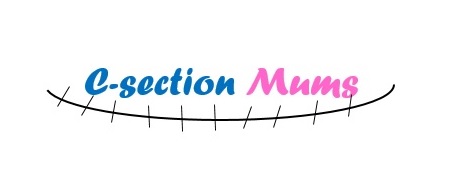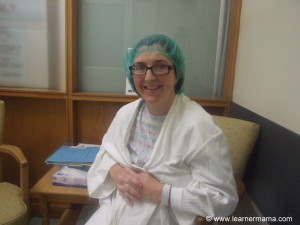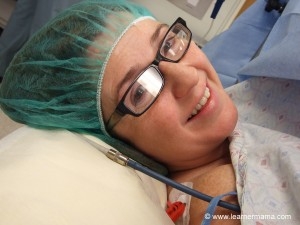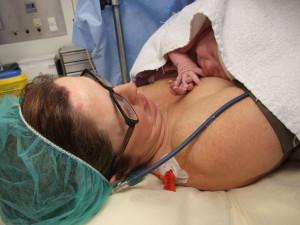Knowing what happens during a C-section can be an exceptionally useful piece of knowledge for any mum-to-be whether or not you plan on having one. In this article we take a general look at what will happen before, during and after a C-section. Obviously every hospital worldwide will have different policies so it is a good idea to ask what your hospitals own policies are when preparing for the birth of your baby.
Pre-surgery
If you are attending for an elective section you may have had a number of weeks or months to prepare. Finally D-day arrives. You will be nervous and excited but no more or less than anyone arriving at a hospital knowing you will shortly meet your baby.
You will be admitted to hospital and brought to your hospital bed. You will have various tests (blood pressure, blood tests and urine) taken and sign your consent forms. You may also speak with the anestatist. In some cases these pre C-section tests may even take place in the day or two before the actual surgery so they are out-of-the-way.
You will be given a hospital gown, compression socks and shower hat style head wear. All very attractive.
You can put your dressing gown and slippers on and will be brought to theatre when they are ready for you. As you will be fasting from the night before an early slot is desirable.
Of course if you are thrust into an emergency section the “pre” part is likely to be a matter of minutes and may all happen in a complete blur with a lot of people and action. You will go from being in the throws of labour to being wheeled off to theatre. At this point the focus will be on getting baby out and less on any questions or queries you might have. This may be scary and is all the more reason for knowing in general terms what may happen.
During Surgery
A C-section is major abdominal surgery so it will take place in an operating theatre with the operating table, lights, sounds and smells of any theatre. This can be disconcerting but forewarned is forearmed.
When you arrive at theatre you will be brought to the operating table and your partner will be brought to get changed into surgical scrubs.
If you have not already you will be given an antacid before an IV line is inserted and you will be connected up to heart / pulse / blood pressure monitoring. You will then have the chosen anaesthetic administered. The most common is a spinal block. This involves sitting up on the operating table and leaning forward while they inject into your back. This is probably the most un-nerving moment but once administered it acts very fast.
In other cases an epidural will be administered or in the event of an emergency section, if you have already had an epidural it will be topped up for surgery. In some cases a general anaesthetic (where you are completely knocked out) will be performed.
With the standard spinal block you will feel your legs suddenly feel warm and heavy and the theatre staff will have you move pretty quickly into a lying position and pillows will be placed at your sides.
As the spinal block takes hold the theatre staff make their preparations. This will include lifting up your gown which can be a bit un-nerving as you lie there pretty much naked and unable to move. They will wash the area around your bump with iodine. This solution is ice-cold so if you don’t feel this you can be sure the spinal block is working. They will also shave around the pubic area. A catheter is inserted but this should be done while you are numb so you shouldn’t feel any of it. You will be covered with surgical covers including one draped in front of your face so you are blocked off from the action. I’m sure most people’s fear is that they will feel it all – but don’t worry they will check that you don’t have any sensation before they begin.
Your partner will be allowed in once all is prepared and they will start. The consultants will talk among themselves and maybe to you too. There will be someone near your head monitoring you and as you are hooked up to all the monitors. The monitors will be beeping away and it can be very scary and disconcerting if they alarm. Rest assured it is all normal. The surgical team will monitor your vitals throughout.
The surgeon will make an incision in your skin and then in your uterus. The bag of waters is broken and as the surgery progresses and the birth of your baby nears you will feel a bit of tugging and pressure but no pain.
Once you have given birth they will show baby to you, the cord is cut and baby taken away to be assessed, cleaned and weighed. This is done in the theatre so you will be able to hear baby crying and moaning away. You may wish to have skin to skin contact – if so make sure you request this as otherwise baby will be dressed (you will need to have brought a nappy, vest, baby gro and hat to theatre) and may just be given to Dad or your surgery partner. If you want skin-to-skin contact they will place baby on your chest. Baby may or may not have been cleaned before skin to skin and may have just a nappy on.
While all this goes on you will be stitched up. This takes about 20-30 minutes before you are brought to recovery.
Of course if there are any complications baby will be rushed off for attention – maybe even to the neonatal intensive care unit. This will obviously be a very emotional and fraught time – if you know this may be a possibility beforehand you will get a chance to discuss what will happen and how best to deal with it on a practical level. Will your partner be there with baby or stay with you? How quickly can you visit baby? How will you handle feeding? Getting these types of queries out-of-the-way in advance will help deal with the scenario when it happens.
Gaining popularity is the Family Centred Cesarean whereby there will be some slight adjustments to the more traditional surgery to make it a less clinical and more intimate experience. You can check out a video with information about Family Centre Cesarean here.
Post Surgery
Once the surgery is complete you will be brought to recovery for anywhere from 20/30 minutes up to an hour where they will monitor you. Every hospital will be different and you may be able to keep your baby with you and start breastfeeding. If you are having an elective section ensure you make these requests in advance if you want them.
Be prepared to start itching. As the spinal starts to wear off your face (and possibly arms) will start to itch. Let the medical team know and they may give you something to counteract it if it’s bad. It isn’t like any ordinary itch – it is stronger and like a tic. You will not be able to stop yourself scratching. Thankfully it eases quickly.
Once all is okay you will be brought to your hospital bed to recover.
Your Hospital Stay
Once back in ward and in your bed you will still be numb – it will take about 6-8 hours to regain the feeling. After about 12 hours they will ask you to stand up and move around a little bit but you will still have your catheter in for up to 24 hours so there will be no need to get up to go to the toilet.
Once the catheter is out you will begin to feel a little human again. You will continue to get pain relief – and don’t scrimp on it! Don’t be a martyr when it comes to taking as much as you are allowed. For the first 48 hours you will likely be on narcotic based pain relief. It can make you a little bit spaced out. Couple heavy pain relief with the fact that you are dealing with a newborn baby and it will make an interesting time.
Bowel wise you may be a little off (to put it nicely). Constipation is not pleasant so make sure you get a laxative or stool softener while still in hospital. The medical team will likely check that you have opened your bowels before you go home but don’t be surprised if you get a bit blocked up and ensure you take action to prevent it once you are home.
You will likely be in hospital for a number of days and by the time you are leaving you should be down to more normal pain killers such as paracetamol / tylenol but make sure you leave the hospital with a prescription for further pain relief and take as required. Don’t let the pain get on top of you because once it does it is difficult to get back on top of it.
If you had staples to close the wound they will likely be removed before you go home (or sometimes a few days after you get home). This will only take a few minutes but may be a little uncomfortable.
Once any staples or stitches are removed you will move to the recovery phase. Check out some recovery tips here.
This article is based on Learner Mama’s Guide to C-sections
All images www.learnermama.com




